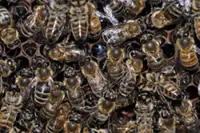Bees need open or cup-shaped flowers whose centres are full of pollen and easy to reach. Photo: dpa/dpa-tmn/Daniel Bockwoldt
Bees are pretty straightforward, without complicated needs.
In order to survive, they need a safe shelter, a place to have and raise offspring and, above all, plenty of food.





